Critical Appraisal of Two Public Health Research Papers - Semester 2
VerifiedAdded on 2022/09/26
|10
|2750
|26
Report
AI Summary
This report presents a critical appraisal of two research papers focusing on public health issues. The first paper, examines the correlation between sugary drink consumption and dental caries in New South Wales teenagers. The report delves into the researchers' aims, framing of the issue, theoretical framework, research questions, strategy, and methods, along with a critique of the approach. The second paper investigates e-cigarettes, their prevalence, and attitudes in Great Britain. The report follows a similar structure, analyzing the authors' framing, theory base, research questions, strategy, and methods, concluding with a comprehensive critique of both papers, highlighting their strengths and weaknesses. The analysis covers aspects such as research bias, theoretical framework, and the effectiveness of the methodologies employed, providing a detailed evaluation of the research approaches used in both studies.
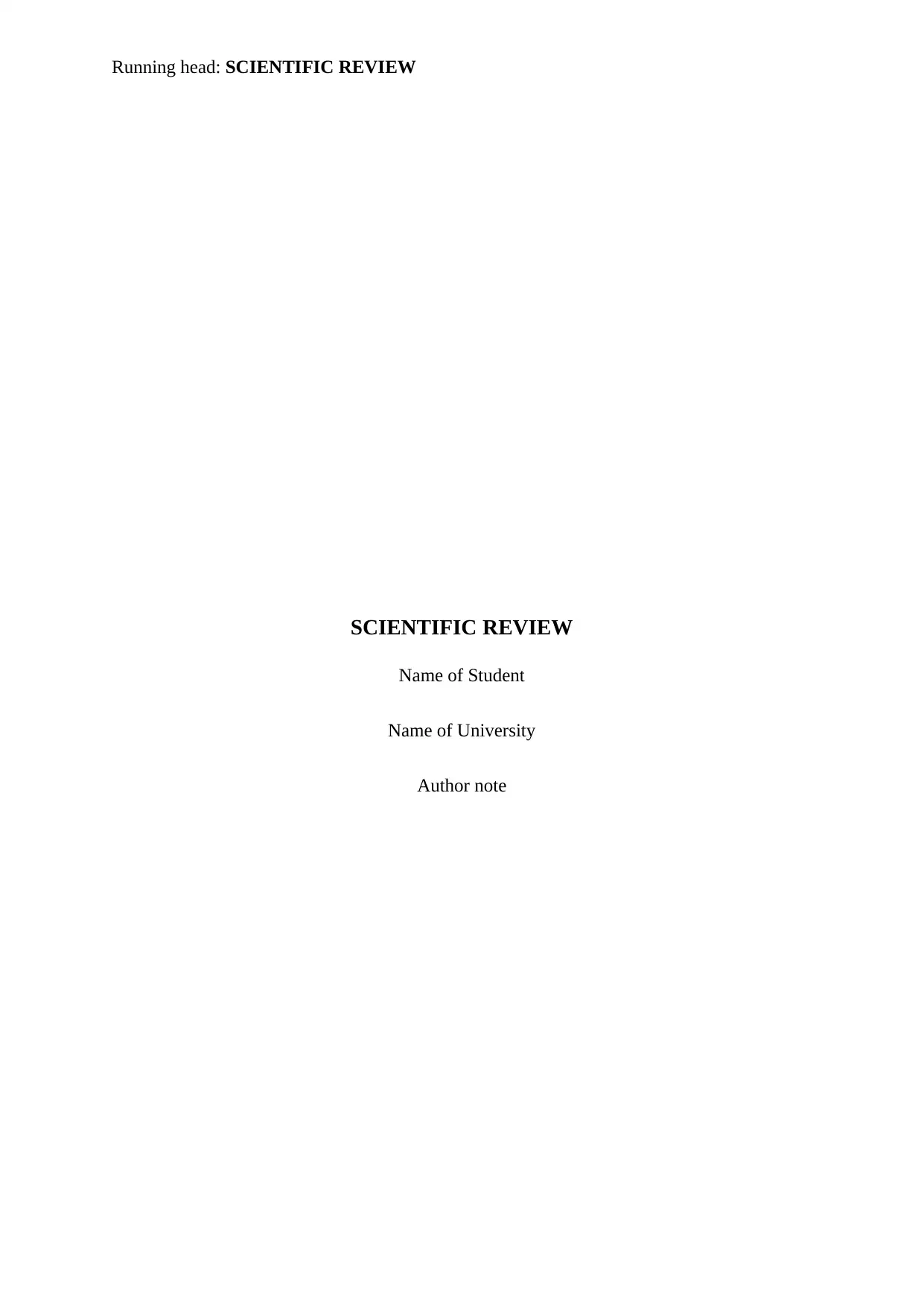
Running head: SCIENTIFIC REVIEW
SCIENTIFIC REVIEW
Name of Student
Name of University
Author note
SCIENTIFIC REVIEW
Name of Student
Name of University
Author note
Paraphrase This Document
Need a fresh take? Get an instant paraphrase of this document with our AI Paraphraser
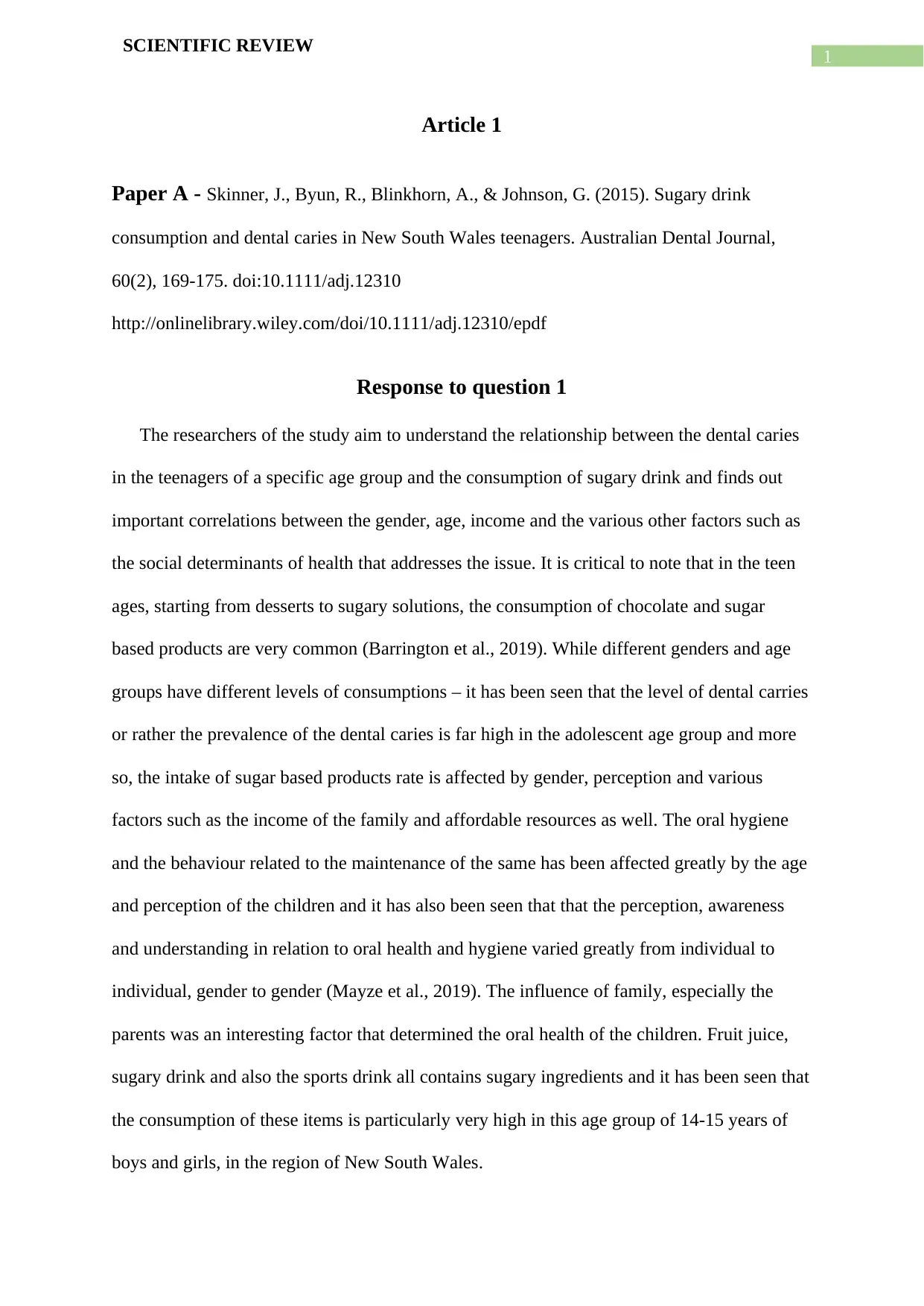
1
SCIENTIFIC REVIEW
Article 1
Paper A - Skinner, J., Byun, R., Blinkhorn, A., & Johnson, G. (2015). Sugary drink
consumption and dental caries in New South Wales teenagers. Australian Dental Journal,
60(2), 169-175. doi:10.1111/adj.12310
http://onlinelibrary.wiley.com/doi/10.1111/adj.12310/epdf
Response to question 1
The researchers of the study aim to understand the relationship between the dental caries
in the teenagers of a specific age group and the consumption of sugary drink and finds out
important correlations between the gender, age, income and the various other factors such as
the social determinants of health that addresses the issue. It is critical to note that in the teen
ages, starting from desserts to sugary solutions, the consumption of chocolate and sugar
based products are very common (Barrington et al., 2019). While different genders and age
groups have different levels of consumptions – it has been seen that the level of dental carries
or rather the prevalence of the dental caries is far high in the adolescent age group and more
so, the intake of sugar based products rate is affected by gender, perception and various
factors such as the income of the family and affordable resources as well. The oral hygiene
and the behaviour related to the maintenance of the same has been affected greatly by the age
and perception of the children and it has also been seen that that the perception, awareness
and understanding in relation to oral health and hygiene varied greatly from individual to
individual, gender to gender (Mayze et al., 2019). The influence of family, especially the
parents was an interesting factor that determined the oral health of the children. Fruit juice,
sugary drink and also the sports drink all contains sugary ingredients and it has been seen that
the consumption of these items is particularly very high in this age group of 14-15 years of
boys and girls, in the region of New South Wales.
SCIENTIFIC REVIEW
Article 1
Paper A - Skinner, J., Byun, R., Blinkhorn, A., & Johnson, G. (2015). Sugary drink
consumption and dental caries in New South Wales teenagers. Australian Dental Journal,
60(2), 169-175. doi:10.1111/adj.12310
http://onlinelibrary.wiley.com/doi/10.1111/adj.12310/epdf
Response to question 1
The researchers of the study aim to understand the relationship between the dental caries
in the teenagers of a specific age group and the consumption of sugary drink and finds out
important correlations between the gender, age, income and the various other factors such as
the social determinants of health that addresses the issue. It is critical to note that in the teen
ages, starting from desserts to sugary solutions, the consumption of chocolate and sugar
based products are very common (Barrington et al., 2019). While different genders and age
groups have different levels of consumptions – it has been seen that the level of dental carries
or rather the prevalence of the dental caries is far high in the adolescent age group and more
so, the intake of sugar based products rate is affected by gender, perception and various
factors such as the income of the family and affordable resources as well. The oral hygiene
and the behaviour related to the maintenance of the same has been affected greatly by the age
and perception of the children and it has also been seen that that the perception, awareness
and understanding in relation to oral health and hygiene varied greatly from individual to
individual, gender to gender (Mayze et al., 2019). The influence of family, especially the
parents was an interesting factor that determined the oral health of the children. Fruit juice,
sugary drink and also the sports drink all contains sugary ingredients and it has been seen that
the consumption of these items is particularly very high in this age group of 14-15 years of
boys and girls, in the region of New South Wales.
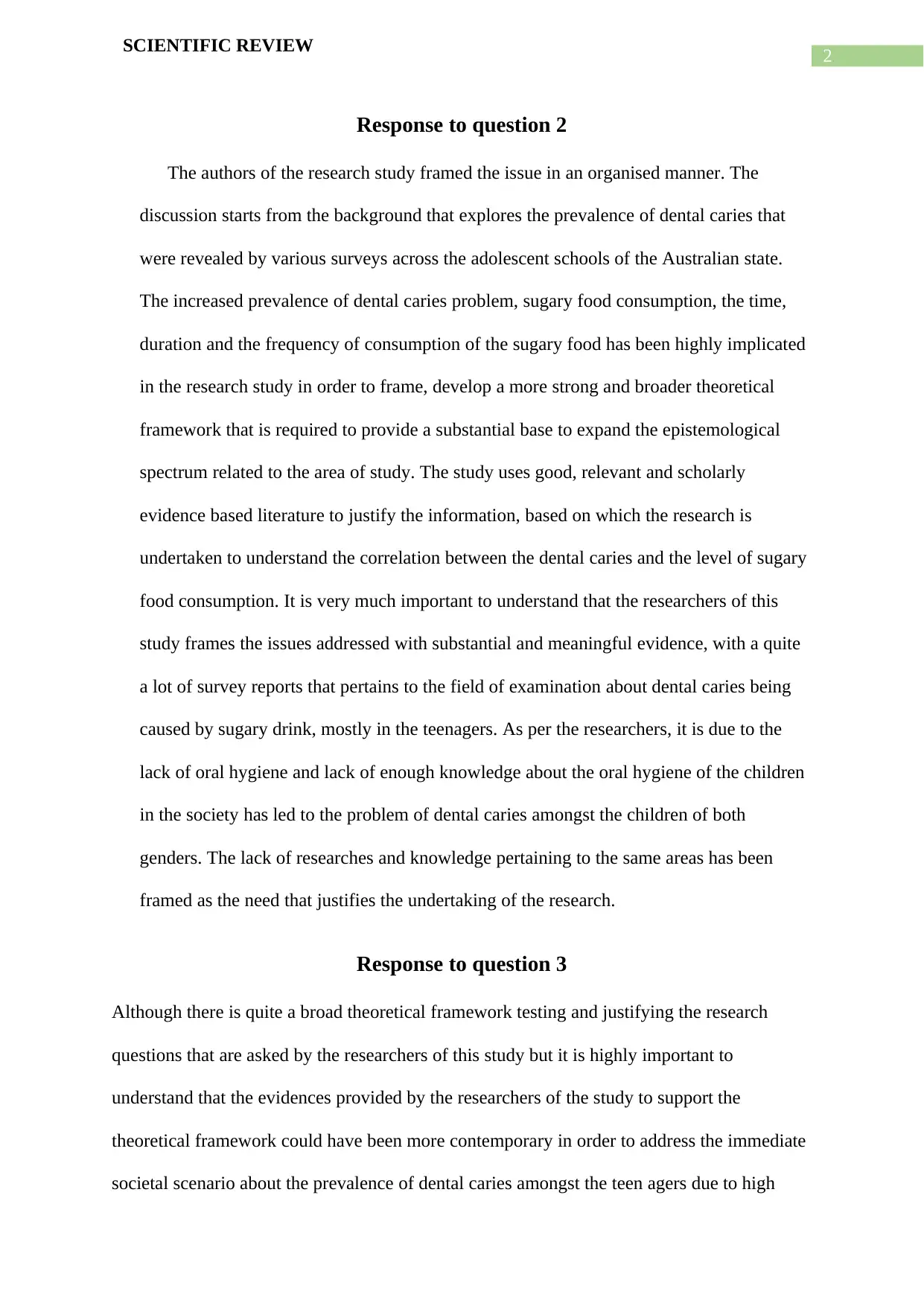
2
SCIENTIFIC REVIEW
Response to question 2
The authors of the research study framed the issue in an organised manner. The
discussion starts from the background that explores the prevalence of dental caries that
were revealed by various surveys across the adolescent schools of the Australian state.
The increased prevalence of dental caries problem, sugary food consumption, the time,
duration and the frequency of consumption of the sugary food has been highly implicated
in the research study in order to frame, develop a more strong and broader theoretical
framework that is required to provide a substantial base to expand the epistemological
spectrum related to the area of study. The study uses good, relevant and scholarly
evidence based literature to justify the information, based on which the research is
undertaken to understand the correlation between the dental caries and the level of sugary
food consumption. It is very much important to understand that the researchers of this
study frames the issues addressed with substantial and meaningful evidence, with a quite
a lot of survey reports that pertains to the field of examination about dental caries being
caused by sugary drink, mostly in the teenagers. As per the researchers, it is due to the
lack of oral hygiene and lack of enough knowledge about the oral hygiene of the children
in the society has led to the problem of dental caries amongst the children of both
genders. The lack of researches and knowledge pertaining to the same areas has been
framed as the need that justifies the undertaking of the research.
Response to question 3
Although there is quite a broad theoretical framework testing and justifying the research
questions that are asked by the researchers of this study but it is highly important to
understand that the evidences provided by the researchers of the study to support the
theoretical framework could have been more contemporary in order to address the immediate
societal scenario about the prevalence of dental caries amongst the teen agers due to high
SCIENTIFIC REVIEW
Response to question 2
The authors of the research study framed the issue in an organised manner. The
discussion starts from the background that explores the prevalence of dental caries that
were revealed by various surveys across the adolescent schools of the Australian state.
The increased prevalence of dental caries problem, sugary food consumption, the time,
duration and the frequency of consumption of the sugary food has been highly implicated
in the research study in order to frame, develop a more strong and broader theoretical
framework that is required to provide a substantial base to expand the epistemological
spectrum related to the area of study. The study uses good, relevant and scholarly
evidence based literature to justify the information, based on which the research is
undertaken to understand the correlation between the dental caries and the level of sugary
food consumption. It is very much important to understand that the researchers of this
study frames the issues addressed with substantial and meaningful evidence, with a quite
a lot of survey reports that pertains to the field of examination about dental caries being
caused by sugary drink, mostly in the teenagers. As per the researchers, it is due to the
lack of oral hygiene and lack of enough knowledge about the oral hygiene of the children
in the society has led to the problem of dental caries amongst the children of both
genders. The lack of researches and knowledge pertaining to the same areas has been
framed as the need that justifies the undertaking of the research.
Response to question 3
Although there is quite a broad theoretical framework testing and justifying the research
questions that are asked by the researchers of this study but it is highly important to
understand that the evidences provided by the researchers of the study to support the
theoretical framework could have been more contemporary in order to address the immediate
societal scenario about the prevalence of dental caries amongst the teen agers due to high
⊘ This is a preview!⊘
Do you want full access?
Subscribe today to unlock all pages.

Trusted by 1+ million students worldwide
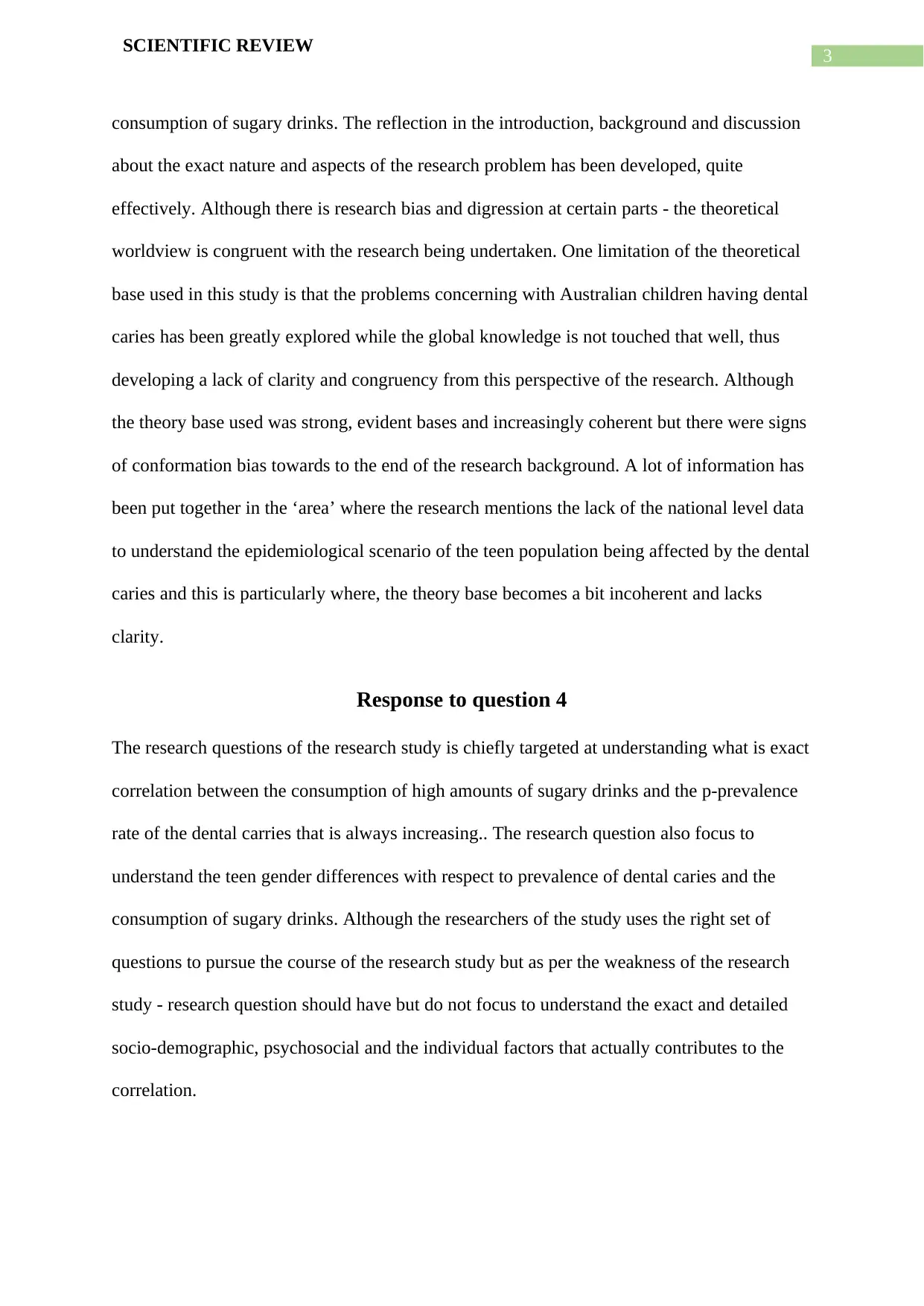
3
SCIENTIFIC REVIEW
consumption of sugary drinks. The reflection in the introduction, background and discussion
about the exact nature and aspects of the research problem has been developed, quite
effectively. Although there is research bias and digression at certain parts - the theoretical
worldview is congruent with the research being undertaken. One limitation of the theoretical
base used in this study is that the problems concerning with Australian children having dental
caries has been greatly explored while the global knowledge is not touched that well, thus
developing a lack of clarity and congruency from this perspective of the research. Although
the theory base used was strong, evident bases and increasingly coherent but there were signs
of conformation bias towards to the end of the research background. A lot of information has
been put together in the ‘area’ where the research mentions the lack of the national level data
to understand the epidemiological scenario of the teen population being affected by the dental
caries and this is particularly where, the theory base becomes a bit incoherent and lacks
clarity.
Response to question 4
The research questions of the research study is chiefly targeted at understanding what is exact
correlation between the consumption of high amounts of sugary drinks and the p-prevalence
rate of the dental carries that is always increasing.. The research question also focus to
understand the teen gender differences with respect to prevalence of dental caries and the
consumption of sugary drinks. Although the researchers of the study uses the right set of
questions to pursue the course of the research study but as per the weakness of the research
study - research question should have but do not focus to understand the exact and detailed
socio-demographic, psychosocial and the individual factors that actually contributes to the
correlation.
SCIENTIFIC REVIEW
consumption of sugary drinks. The reflection in the introduction, background and discussion
about the exact nature and aspects of the research problem has been developed, quite
effectively. Although there is research bias and digression at certain parts - the theoretical
worldview is congruent with the research being undertaken. One limitation of the theoretical
base used in this study is that the problems concerning with Australian children having dental
caries has been greatly explored while the global knowledge is not touched that well, thus
developing a lack of clarity and congruency from this perspective of the research. Although
the theory base used was strong, evident bases and increasingly coherent but there were signs
of conformation bias towards to the end of the research background. A lot of information has
been put together in the ‘area’ where the research mentions the lack of the national level data
to understand the epidemiological scenario of the teen population being affected by the dental
caries and this is particularly where, the theory base becomes a bit incoherent and lacks
clarity.
Response to question 4
The research questions of the research study is chiefly targeted at understanding what is exact
correlation between the consumption of high amounts of sugary drinks and the p-prevalence
rate of the dental carries that is always increasing.. The research question also focus to
understand the teen gender differences with respect to prevalence of dental caries and the
consumption of sugary drinks. Although the researchers of the study uses the right set of
questions to pursue the course of the research study but as per the weakness of the research
study - research question should have but do not focus to understand the exact and detailed
socio-demographic, psychosocial and the individual factors that actually contributes to the
correlation.
Paraphrase This Document
Need a fresh take? Get an instant paraphrase of this document with our AI Paraphraser
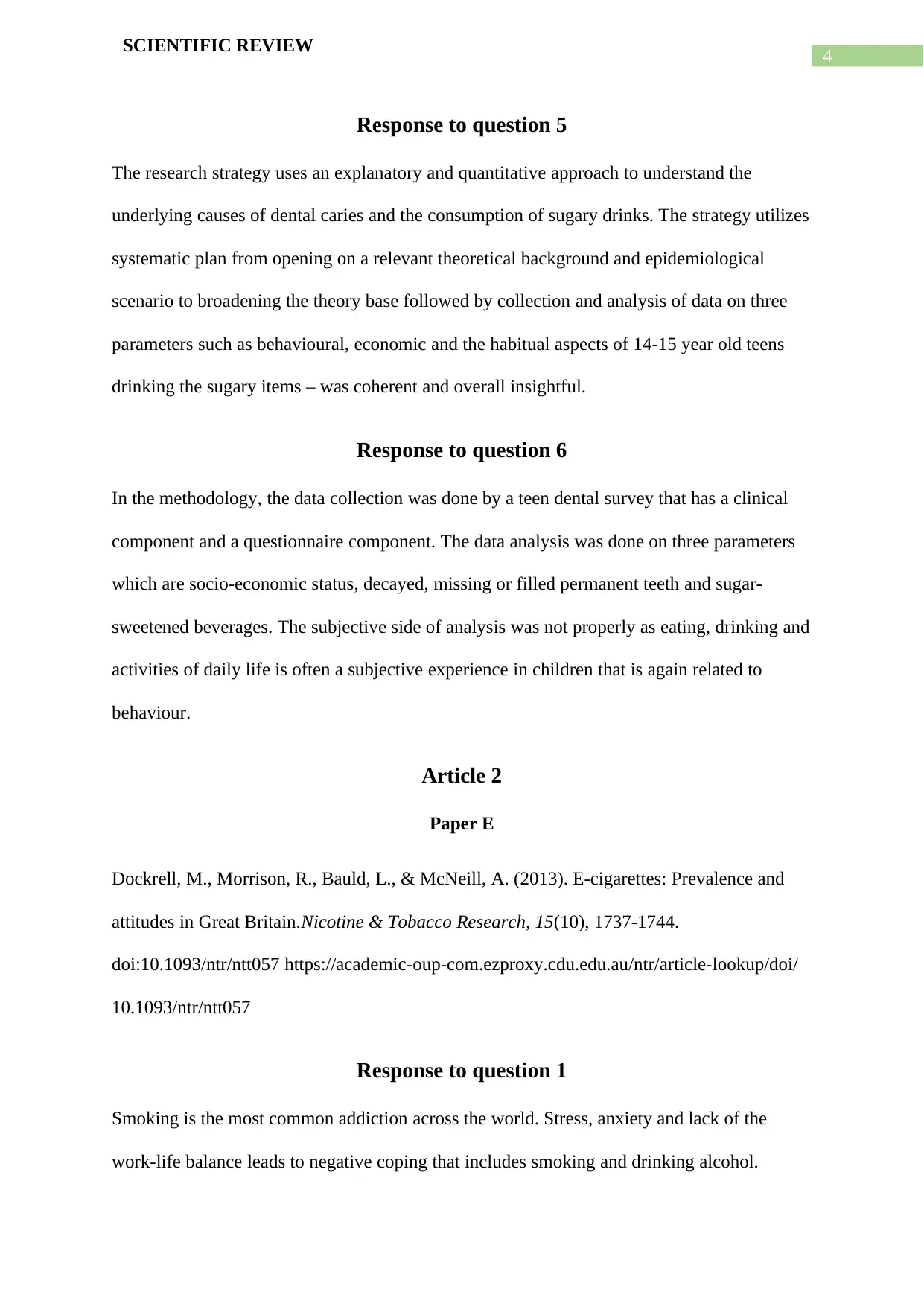
4
SCIENTIFIC REVIEW
Response to question 5
The research strategy uses an explanatory and quantitative approach to understand the
underlying causes of dental caries and the consumption of sugary drinks. The strategy utilizes
systematic plan from opening on a relevant theoretical background and epidemiological
scenario to broadening the theory base followed by collection and analysis of data on three
parameters such as behavioural, economic and the habitual aspects of 14-15 year old teens
drinking the sugary items – was coherent and overall insightful.
Response to question 6
In the methodology, the data collection was done by a teen dental survey that has a clinical
component and a questionnaire component. The data analysis was done on three parameters
which are socio‐economic status, decayed, missing or filled permanent teeth and sugar‐
sweetened beverages. The subjective side of analysis was not properly as eating, drinking and
activities of daily life is often a subjective experience in children that is again related to
behaviour.
Article 2
Paper E
Dockrell, M., Morrison, R., Bauld, L., & McNeill, A. (2013). E-cigarettes: Prevalence and
attitudes in Great Britain.Nicotine & Tobacco Research, 15(10), 1737-1744.
doi:10.1093/ntr/ntt057 https://academic-oup-com.ezproxy.cdu.edu.au/ntr/article-lookup/doi/
10.1093/ntr/ntt057
Response to question 1
Smoking is the most common addiction across the world. Stress, anxiety and lack of the
work-life balance leads to negative coping that includes smoking and drinking alcohol.
SCIENTIFIC REVIEW
Response to question 5
The research strategy uses an explanatory and quantitative approach to understand the
underlying causes of dental caries and the consumption of sugary drinks. The strategy utilizes
systematic plan from opening on a relevant theoretical background and epidemiological
scenario to broadening the theory base followed by collection and analysis of data on three
parameters such as behavioural, economic and the habitual aspects of 14-15 year old teens
drinking the sugary items – was coherent and overall insightful.
Response to question 6
In the methodology, the data collection was done by a teen dental survey that has a clinical
component and a questionnaire component. The data analysis was done on three parameters
which are socio‐economic status, decayed, missing or filled permanent teeth and sugar‐
sweetened beverages. The subjective side of analysis was not properly as eating, drinking and
activities of daily life is often a subjective experience in children that is again related to
behaviour.
Article 2
Paper E
Dockrell, M., Morrison, R., Bauld, L., & McNeill, A. (2013). E-cigarettes: Prevalence and
attitudes in Great Britain.Nicotine & Tobacco Research, 15(10), 1737-1744.
doi:10.1093/ntr/ntt057 https://academic-oup-com.ezproxy.cdu.edu.au/ntr/article-lookup/doi/
10.1093/ntr/ntt057
Response to question 1
Smoking is the most common addiction across the world. Stress, anxiety and lack of the
work-life balance leads to negative coping that includes smoking and drinking alcohol.
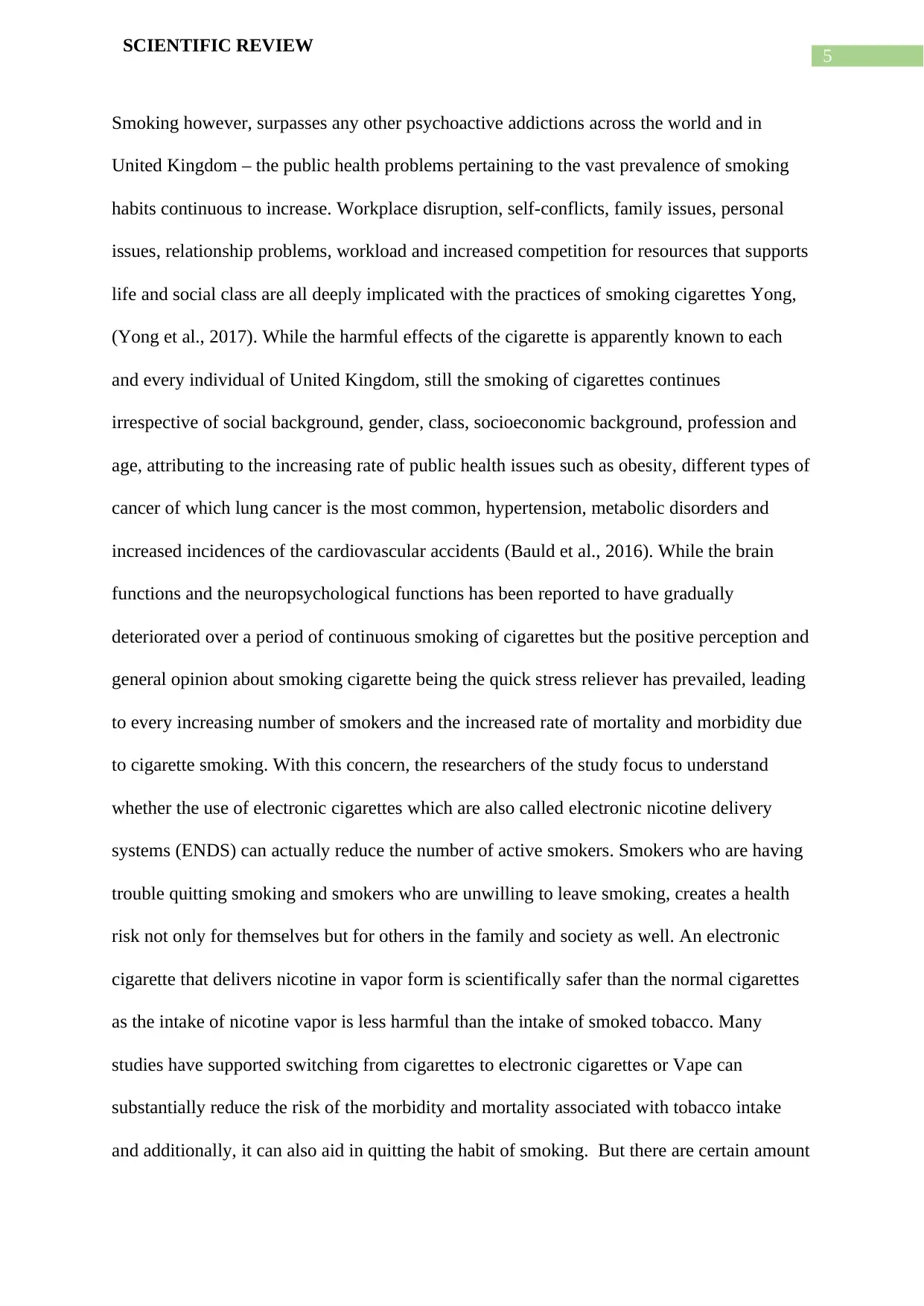
5
SCIENTIFIC REVIEW
Smoking however, surpasses any other psychoactive addictions across the world and in
United Kingdom – the public health problems pertaining to the vast prevalence of smoking
habits continuous to increase. Workplace disruption, self-conflicts, family issues, personal
issues, relationship problems, workload and increased competition for resources that supports
life and social class are all deeply implicated with the practices of smoking cigarettes Yong,
(Yong et al., 2017). While the harmful effects of the cigarette is apparently known to each
and every individual of United Kingdom, still the smoking of cigarettes continues
irrespective of social background, gender, class, socioeconomic background, profession and
age, attributing to the increasing rate of public health issues such as obesity, different types of
cancer of which lung cancer is the most common, hypertension, metabolic disorders and
increased incidences of the cardiovascular accidents (Bauld et al., 2016). While the brain
functions and the neuropsychological functions has been reported to have gradually
deteriorated over a period of continuous smoking of cigarettes but the positive perception and
general opinion about smoking cigarette being the quick stress reliever has prevailed, leading
to every increasing number of smokers and the increased rate of mortality and morbidity due
to cigarette smoking. With this concern, the researchers of the study focus to understand
whether the use of electronic cigarettes which are also called electronic nicotine delivery
systems (ENDS) can actually reduce the number of active smokers. Smokers who are having
trouble quitting smoking and smokers who are unwilling to leave smoking, creates a health
risk not only for themselves but for others in the family and society as well. An electronic
cigarette that delivers nicotine in vapor form is scientifically safer than the normal cigarettes
as the intake of nicotine vapor is less harmful than the intake of smoked tobacco. Many
studies have supported switching from cigarettes to electronic cigarettes or Vape can
substantially reduce the risk of the morbidity and mortality associated with tobacco intake
and additionally, it can also aid in quitting the habit of smoking. But there are certain amount
SCIENTIFIC REVIEW
Smoking however, surpasses any other psychoactive addictions across the world and in
United Kingdom – the public health problems pertaining to the vast prevalence of smoking
habits continuous to increase. Workplace disruption, self-conflicts, family issues, personal
issues, relationship problems, workload and increased competition for resources that supports
life and social class are all deeply implicated with the practices of smoking cigarettes Yong,
(Yong et al., 2017). While the harmful effects of the cigarette is apparently known to each
and every individual of United Kingdom, still the smoking of cigarettes continues
irrespective of social background, gender, class, socioeconomic background, profession and
age, attributing to the increasing rate of public health issues such as obesity, different types of
cancer of which lung cancer is the most common, hypertension, metabolic disorders and
increased incidences of the cardiovascular accidents (Bauld et al., 2016). While the brain
functions and the neuropsychological functions has been reported to have gradually
deteriorated over a period of continuous smoking of cigarettes but the positive perception and
general opinion about smoking cigarette being the quick stress reliever has prevailed, leading
to every increasing number of smokers and the increased rate of mortality and morbidity due
to cigarette smoking. With this concern, the researchers of the study focus to understand
whether the use of electronic cigarettes which are also called electronic nicotine delivery
systems (ENDS) can actually reduce the number of active smokers. Smokers who are having
trouble quitting smoking and smokers who are unwilling to leave smoking, creates a health
risk not only for themselves but for others in the family and society as well. An electronic
cigarette that delivers nicotine in vapor form is scientifically safer than the normal cigarettes
as the intake of nicotine vapor is less harmful than the intake of smoked tobacco. Many
studies have supported switching from cigarettes to electronic cigarettes or Vape can
substantially reduce the risk of the morbidity and mortality associated with tobacco intake
and additionally, it can also aid in quitting the habit of smoking. But there are certain amount
⊘ This is a preview!⊘
Do you want full access?
Subscribe today to unlock all pages.

Trusted by 1+ million students worldwide
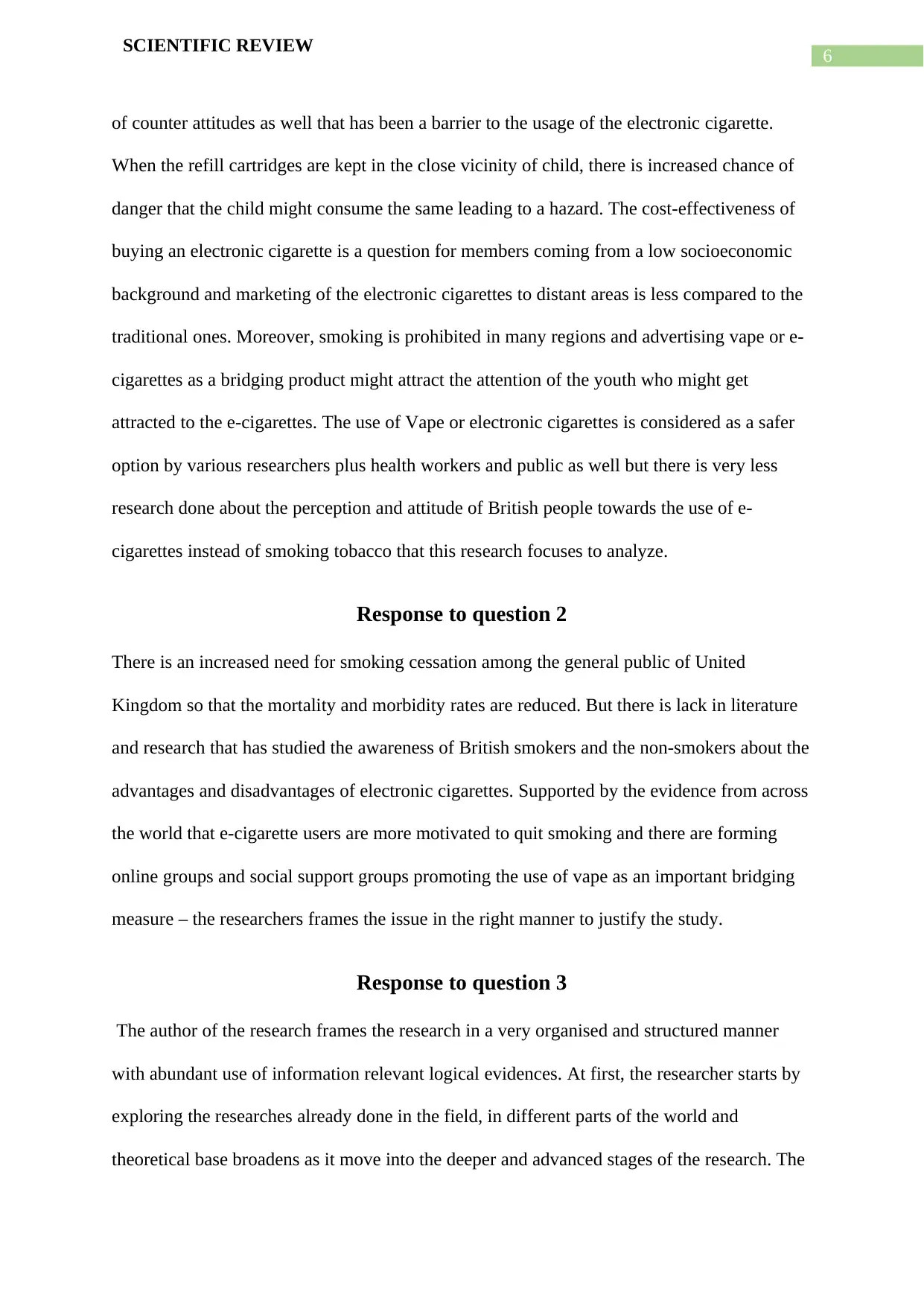
6
SCIENTIFIC REVIEW
of counter attitudes as well that has been a barrier to the usage of the electronic cigarette.
When the refill cartridges are kept in the close vicinity of child, there is increased chance of
danger that the child might consume the same leading to a hazard. The cost-effectiveness of
buying an electronic cigarette is a question for members coming from a low socioeconomic
background and marketing of the electronic cigarettes to distant areas is less compared to the
traditional ones. Moreover, smoking is prohibited in many regions and advertising vape or e-
cigarettes as a bridging product might attract the attention of the youth who might get
attracted to the e-cigarettes. The use of Vape or electronic cigarettes is considered as a safer
option by various researchers plus health workers and public as well but there is very less
research done about the perception and attitude of British people towards the use of e-
cigarettes instead of smoking tobacco that this research focuses to analyze.
Response to question 2
There is an increased need for smoking cessation among the general public of United
Kingdom so that the mortality and morbidity rates are reduced. But there is lack in literature
and research that has studied the awareness of British smokers and the non-smokers about the
advantages and disadvantages of electronic cigarettes. Supported by the evidence from across
the world that e-cigarette users are more motivated to quit smoking and there are forming
online groups and social support groups promoting the use of vape as an important bridging
measure – the researchers frames the issue in the right manner to justify the study.
Response to question 3
The author of the research frames the research in a very organised and structured manner
with abundant use of information relevant logical evidences. At first, the researcher starts by
exploring the researches already done in the field, in different parts of the world and
theoretical base broadens as it move into the deeper and advanced stages of the research. The
SCIENTIFIC REVIEW
of counter attitudes as well that has been a barrier to the usage of the electronic cigarette.
When the refill cartridges are kept in the close vicinity of child, there is increased chance of
danger that the child might consume the same leading to a hazard. The cost-effectiveness of
buying an electronic cigarette is a question for members coming from a low socioeconomic
background and marketing of the electronic cigarettes to distant areas is less compared to the
traditional ones. Moreover, smoking is prohibited in many regions and advertising vape or e-
cigarettes as a bridging product might attract the attention of the youth who might get
attracted to the e-cigarettes. The use of Vape or electronic cigarettes is considered as a safer
option by various researchers plus health workers and public as well but there is very less
research done about the perception and attitude of British people towards the use of e-
cigarettes instead of smoking tobacco that this research focuses to analyze.
Response to question 2
There is an increased need for smoking cessation among the general public of United
Kingdom so that the mortality and morbidity rates are reduced. But there is lack in literature
and research that has studied the awareness of British smokers and the non-smokers about the
advantages and disadvantages of electronic cigarettes. Supported by the evidence from across
the world that e-cigarette users are more motivated to quit smoking and there are forming
online groups and social support groups promoting the use of vape as an important bridging
measure – the researchers frames the issue in the right manner to justify the study.
Response to question 3
The author of the research frames the research in a very organised and structured manner
with abundant use of information relevant logical evidences. At first, the researcher starts by
exploring the researches already done in the field, in different parts of the world and
theoretical base broadens as it move into the deeper and advanced stages of the research. The
Paraphrase This Document
Need a fresh take? Get an instant paraphrase of this document with our AI Paraphraser
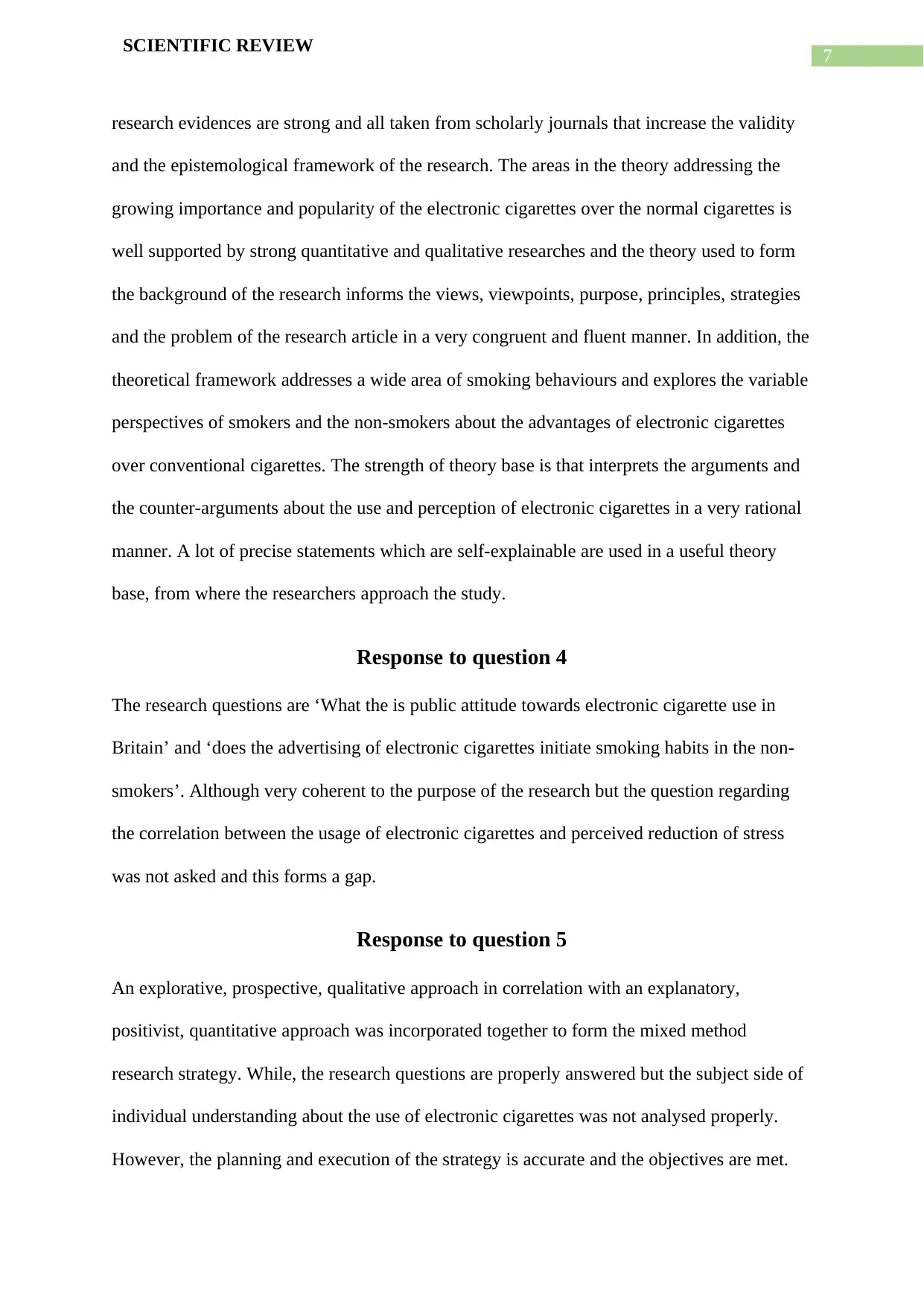
7
SCIENTIFIC REVIEW
research evidences are strong and all taken from scholarly journals that increase the validity
and the epistemological framework of the research. The areas in the theory addressing the
growing importance and popularity of the electronic cigarettes over the normal cigarettes is
well supported by strong quantitative and qualitative researches and the theory used to form
the background of the research informs the views, viewpoints, purpose, principles, strategies
and the problem of the research article in a very congruent and fluent manner. In addition, the
theoretical framework addresses a wide area of smoking behaviours and explores the variable
perspectives of smokers and the non-smokers about the advantages of electronic cigarettes
over conventional cigarettes. The strength of theory base is that interprets the arguments and
the counter-arguments about the use and perception of electronic cigarettes in a very rational
manner. A lot of precise statements which are self-explainable are used in a useful theory
base, from where the researchers approach the study.
Response to question 4
The research questions are ‘What the is public attitude towards electronic cigarette use in
Britain’ and ‘does the advertising of electronic cigarettes initiate smoking habits in the non-
smokers’. Although very coherent to the purpose of the research but the question regarding
the correlation between the usage of electronic cigarettes and perceived reduction of stress
was not asked and this forms a gap.
Response to question 5
An explorative, prospective, qualitative approach in correlation with an explanatory,
positivist, quantitative approach was incorporated together to form the mixed method
research strategy. While, the research questions are properly answered but the subject side of
individual understanding about the use of electronic cigarettes was not analysed properly.
However, the planning and execution of the strategy is accurate and the objectives are met.
SCIENTIFIC REVIEW
research evidences are strong and all taken from scholarly journals that increase the validity
and the epistemological framework of the research. The areas in the theory addressing the
growing importance and popularity of the electronic cigarettes over the normal cigarettes is
well supported by strong quantitative and qualitative researches and the theory used to form
the background of the research informs the views, viewpoints, purpose, principles, strategies
and the problem of the research article in a very congruent and fluent manner. In addition, the
theoretical framework addresses a wide area of smoking behaviours and explores the variable
perspectives of smokers and the non-smokers about the advantages of electronic cigarettes
over conventional cigarettes. The strength of theory base is that interprets the arguments and
the counter-arguments about the use and perception of electronic cigarettes in a very rational
manner. A lot of precise statements which are self-explainable are used in a useful theory
base, from where the researchers approach the study.
Response to question 4
The research questions are ‘What the is public attitude towards electronic cigarette use in
Britain’ and ‘does the advertising of electronic cigarettes initiate smoking habits in the non-
smokers’. Although very coherent to the purpose of the research but the question regarding
the correlation between the usage of electronic cigarettes and perceived reduction of stress
was not asked and this forms a gap.
Response to question 5
An explorative, prospective, qualitative approach in correlation with an explanatory,
positivist, quantitative approach was incorporated together to form the mixed method
research strategy. While, the research questions are properly answered but the subject side of
individual understanding about the use of electronic cigarettes was not analysed properly.
However, the planning and execution of the strategy is accurate and the objectives are met.
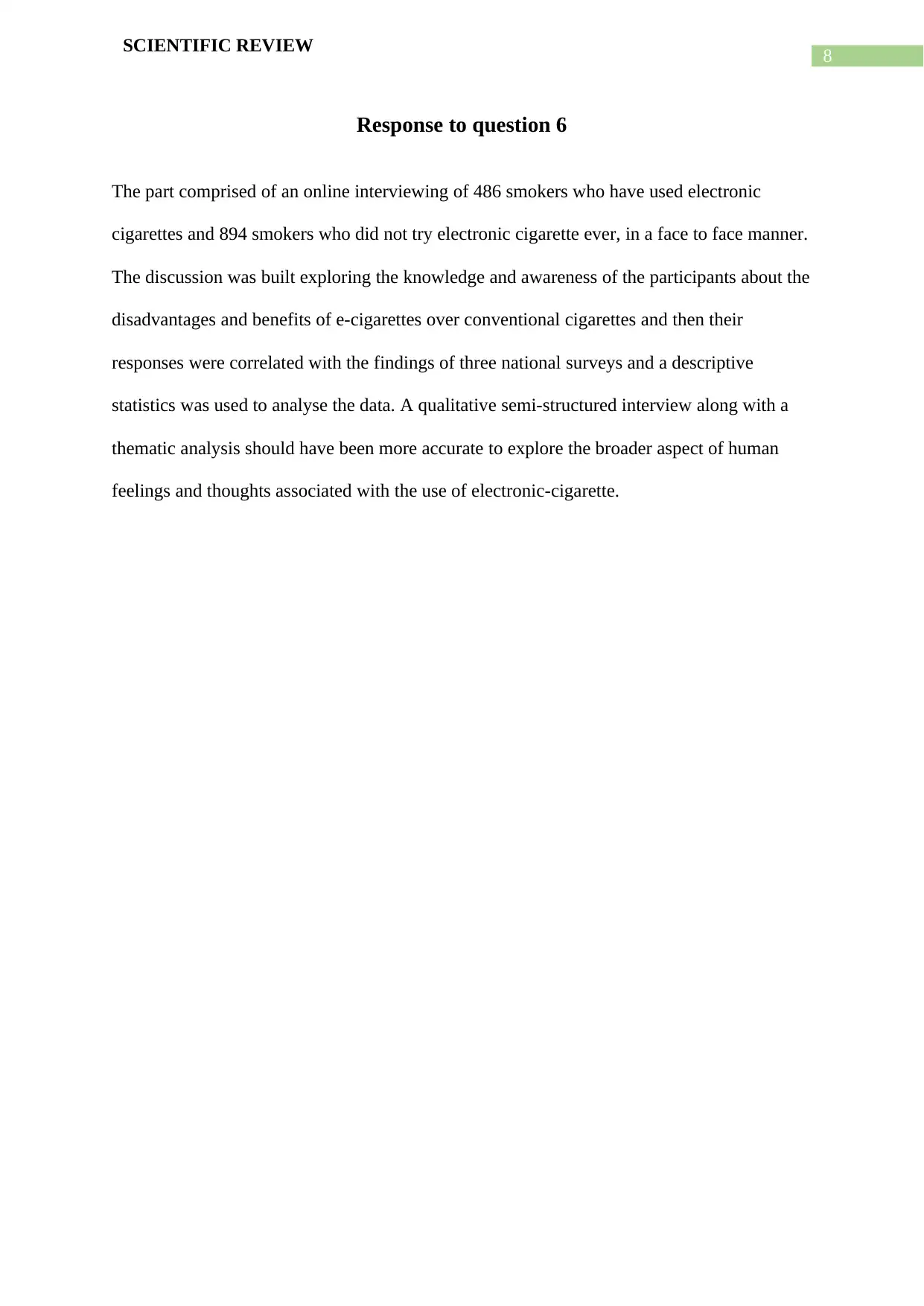
8
SCIENTIFIC REVIEW
Response to question 6
The part comprised of an online interviewing of 486 smokers who have used electronic
cigarettes and 894 smokers who did not try electronic cigarette ever, in a face to face manner.
The discussion was built exploring the knowledge and awareness of the participants about the
disadvantages and benefits of e-cigarettes over conventional cigarettes and then their
responses were correlated with the findings of three national surveys and a descriptive
statistics was used to analyse the data. A qualitative semi-structured interview along with a
thematic analysis should have been more accurate to explore the broader aspect of human
feelings and thoughts associated with the use of electronic-cigarette.
SCIENTIFIC REVIEW
Response to question 6
The part comprised of an online interviewing of 486 smokers who have used electronic
cigarettes and 894 smokers who did not try electronic cigarette ever, in a face to face manner.
The discussion was built exploring the knowledge and awareness of the participants about the
disadvantages and benefits of e-cigarettes over conventional cigarettes and then their
responses were correlated with the findings of three national surveys and a descriptive
statistics was used to analyse the data. A qualitative semi-structured interview along with a
thematic analysis should have been more accurate to explore the broader aspect of human
feelings and thoughts associated with the use of electronic-cigarette.
⊘ This is a preview!⊘
Do you want full access?
Subscribe today to unlock all pages.

Trusted by 1+ million students worldwide
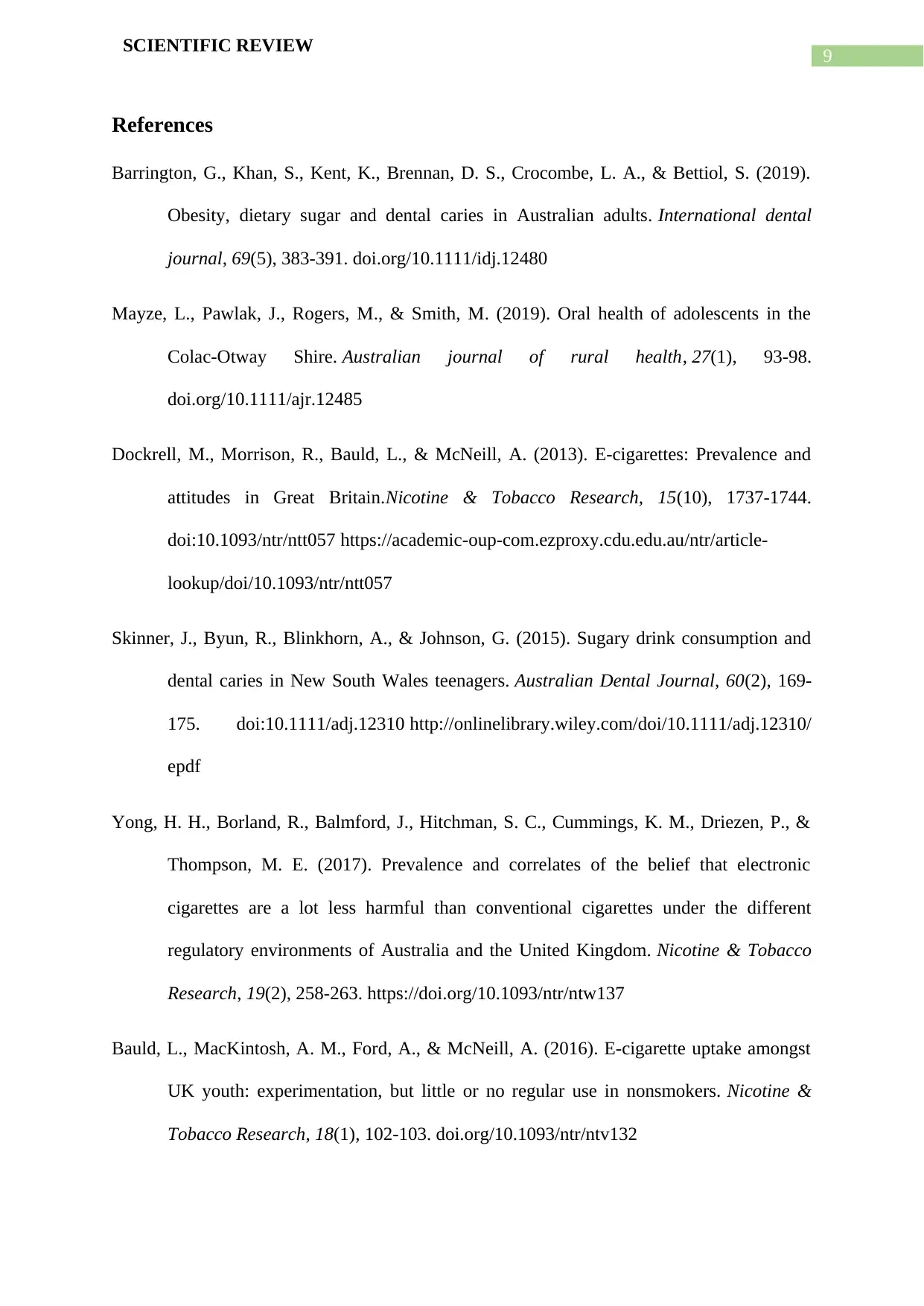
9
SCIENTIFIC REVIEW
References
Barrington, G., Khan, S., Kent, K., Brennan, D. S., Crocombe, L. A., & Bettiol, S. (2019).
Obesity, dietary sugar and dental caries in Australian adults. International dental
journal, 69(5), 383-391. doi.org/10.1111/idj.12480
Mayze, L., Pawlak, J., Rogers, M., & Smith, M. (2019). Oral health of adolescents in the
Colac‐Otway Shire. Australian journal of rural health, 27(1), 93-98.
doi.org/10.1111/ajr.12485
Dockrell, M., Morrison, R., Bauld, L., & McNeill, A. (2013). E-cigarettes: Prevalence and
attitudes in Great Britain.Nicotine & Tobacco Research, 15(10), 1737-1744.
doi:10.1093/ntr/ntt057 https://academic-oup-com.ezproxy.cdu.edu.au/ntr/article-
lookup/doi/10.1093/ntr/ntt057
Skinner, J., Byun, R., Blinkhorn, A., & Johnson, G. (2015). Sugary drink consumption and
dental caries in New South Wales teenagers. Australian Dental Journal, 60(2), 169-
175. doi:10.1111/adj.12310 http://onlinelibrary.wiley.com/doi/10.1111/adj.12310/
epdf
Yong, H. H., Borland, R., Balmford, J., Hitchman, S. C., Cummings, K. M., Driezen, P., &
Thompson, M. E. (2017). Prevalence and correlates of the belief that electronic
cigarettes are a lot less harmful than conventional cigarettes under the different
regulatory environments of Australia and the United Kingdom. Nicotine & Tobacco
Research, 19(2), 258-263. https://doi.org/10.1093/ntr/ntw137
Bauld, L., MacKintosh, A. M., Ford, A., & McNeill, A. (2016). E-cigarette uptake amongst
UK youth: experimentation, but little or no regular use in nonsmokers. Nicotine &
Tobacco Research, 18(1), 102-103. doi.org/10.1093/ntr/ntv132
SCIENTIFIC REVIEW
References
Barrington, G., Khan, S., Kent, K., Brennan, D. S., Crocombe, L. A., & Bettiol, S. (2019).
Obesity, dietary sugar and dental caries in Australian adults. International dental
journal, 69(5), 383-391. doi.org/10.1111/idj.12480
Mayze, L., Pawlak, J., Rogers, M., & Smith, M. (2019). Oral health of adolescents in the
Colac‐Otway Shire. Australian journal of rural health, 27(1), 93-98.
doi.org/10.1111/ajr.12485
Dockrell, M., Morrison, R., Bauld, L., & McNeill, A. (2013). E-cigarettes: Prevalence and
attitudes in Great Britain.Nicotine & Tobacco Research, 15(10), 1737-1744.
doi:10.1093/ntr/ntt057 https://academic-oup-com.ezproxy.cdu.edu.au/ntr/article-
lookup/doi/10.1093/ntr/ntt057
Skinner, J., Byun, R., Blinkhorn, A., & Johnson, G. (2015). Sugary drink consumption and
dental caries in New South Wales teenagers. Australian Dental Journal, 60(2), 169-
175. doi:10.1111/adj.12310 http://onlinelibrary.wiley.com/doi/10.1111/adj.12310/
epdf
Yong, H. H., Borland, R., Balmford, J., Hitchman, S. C., Cummings, K. M., Driezen, P., &
Thompson, M. E. (2017). Prevalence and correlates of the belief that electronic
cigarettes are a lot less harmful than conventional cigarettes under the different
regulatory environments of Australia and the United Kingdom. Nicotine & Tobacco
Research, 19(2), 258-263. https://doi.org/10.1093/ntr/ntw137
Bauld, L., MacKintosh, A. M., Ford, A., & McNeill, A. (2016). E-cigarette uptake amongst
UK youth: experimentation, but little or no regular use in nonsmokers. Nicotine &
Tobacco Research, 18(1), 102-103. doi.org/10.1093/ntr/ntv132
1 out of 10
Your All-in-One AI-Powered Toolkit for Academic Success.
+13062052269
info@desklib.com
Available 24*7 on WhatsApp / Email
![[object Object]](/_next/static/media/star-bottom.7253800d.svg)
Unlock your academic potential
Copyright © 2020–2025 A2Z Services. All Rights Reserved. Developed and managed by ZUCOL.

